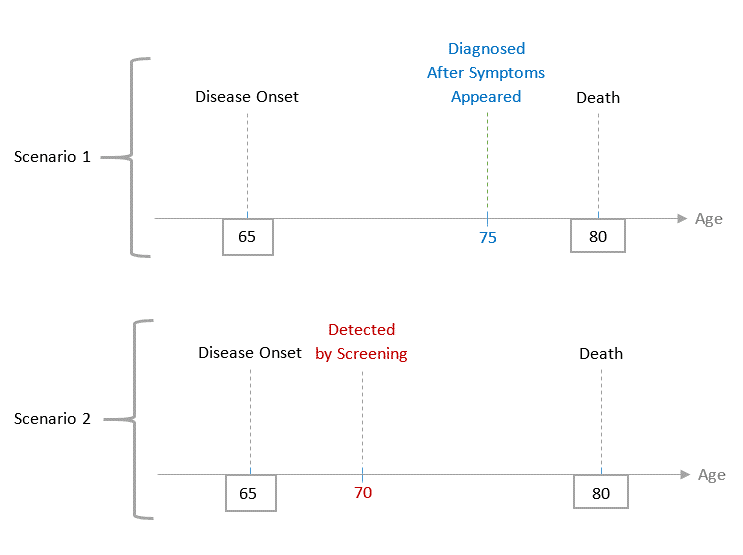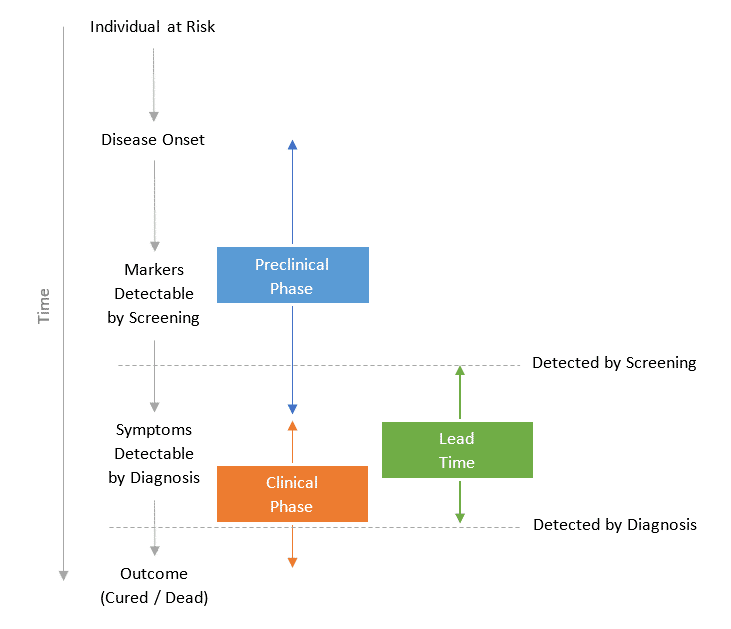Lead time bias occurs when cases who were detected by screening seem to have survived longer than diagnosed cases just because the disease was detected earlier, not because death was delayed.
For example:
Consider the following 2 scenarios of a patient who suffers from dementia since the age of 65:
- Scenario 1: The patient was not diagnosed until symptoms of cognitive decline were pronounced at the age of 75.
- Scenario 2: The patient was diagnosed early with a screening test at age 70 before obvious signs of the disease were present.

Notice that screening did NOT prolong the life of our patient since he died at age 80 anyway.
However, in real life we can’t have such information as only 1 of these 2 scenarios will happen!
Now, if this example is typical in dementia patients, then studies in this field will show that:
- Diagnosed patients will live on average 5 years after detection of the disease
- And screened patients will live on average 10 years after detection of the disease
Therefore, if we only look at survival after disease detection, we would be biased to think that screening prolonged the life of dementia patients.
This bias is referred to as: Lead time bias.
A note on lead time:
The figure below represents the natural history of disease in an individual, starting with being at risk and ending with the outcome:

Lead time is the time gained by detecting the disease earlier because of screening.
How to avoid lead time bias
We can correct for lead time bias in 2 ways:
Solution #1: Get an estimate of the lead time
If we can estimate the lead time, then instead of comparing survival between screened and unscreened, we can compare:
(Survival in the screened group) versus (Survival in the unscreened group + our estimate of the lead time).
If survival in the screened group is longer, then we can conclude that screening is beneficial in terms of mortality. Lets go back to the dementia example above, if we have some theoretical reason to believe that the lead time is ~5 years, then:
| Quantity | Value |
| Survival in the screened group | 10 years |
| Survival in the unscreened group | 5 years |
| Our estimate of the lead time | 5 years |
And because:
Survival in the screened group = Survival in the unscreened group + Our estimate of the lead time
(10 = 5 + 5)
We can conclude that screening does not prolong the life of dementia patients. Now suppose that for some reason we cannot get an acceptable estimate of the lead time. In this case we can use solution #2.
Solution #2: Compare mortality rate between groups instead of the survival time
As we saw above, comparing survival time between screened and unscreened is subject to lead time bias.
This is because survival duration can be increased in 2 ways:
- By reducing mortality
- By diagnosing the disease earlier (which causes lead time bias)
So instead of comparing survival duration between 2 groups, we can compare the mortality rate — which is the number of people who die annually from the disease.
Unlike survival duration, mortality rate is not subject to lead time bias as it can be reduced only by reducing mortality from the disease.
Final note: In determining the benefit of a screening program, we must be careful not to be fooled by lead time bias and length time bias (read more about length time bias here).